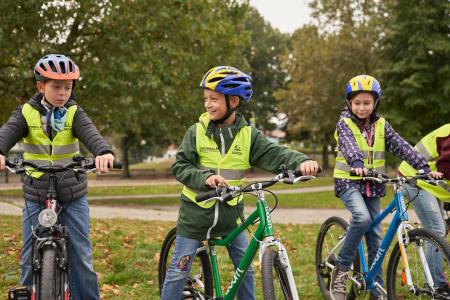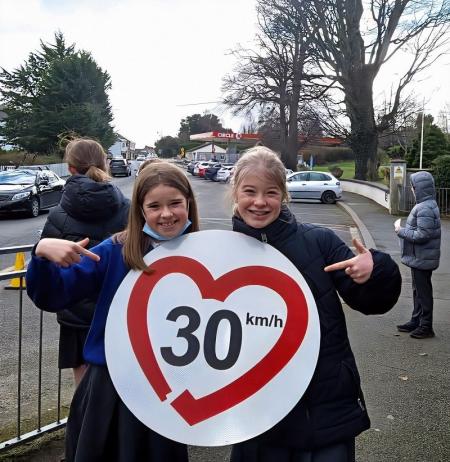Our members are dedicated to improving road safety and sharing their knowledge with the wider community. Here, you can explore our members' good practices – initiatives that have been assessed for their effectiveness in addressing a road safety problem and have proven results.
Get inspired – and sign up to share your good practices too!

Friday, June 2, 2023
In-depth accidents analysis is a unique research activity conducted by Transport Research Centre (CDV). Data from In-depth Accident Analysis provide a comprehensive view of all the factors related to a particular accident and serve to identify the characteristics leading to the crash occurrence and how they affect its consequences.
In – depth Road Accident Analysis includes following research areas:
-transport infrastructure,
-vehicle design and construction,
-human factor and psychology
-medical research.
Our activities are realized in long-term horizon and all the research is subjected to strict conditions, including personal data protection.
We conduct traffic accident research within the National Centre of Czech In-Depth Accidents Analysis (CzIDAS). One of its aims is cooperation with entities that could further use the results of research, for example road owners or administrators, vehicle designers and also researchers etc.
The CzIDAS data is used for various purposes and helps to face current road safety challenges:
- Due to its comprehensiveness, Czech in-depth crash analysis is one of the most effective tools for targeted and comprehensive decision-making on measures related to road safety and the establishment of the National Road Safety Strategy and other government documents related to road safety.
CzIDAS is a source of unique information for targeting preventive information campaigns. The use of in-depth data allows us to influence road users using real crash scenarios with their consequences and highlights specific risky behavior.
the database creates also a unique framework for a number of educational activities, e.g. Education on children's traffic behavior in the form of LARP, methodology for teachers of traffic education, Seniors in road traffic, e-TESTs and teaching and training methodology for the initial education of examiners and for subsequent periodic education of examiners,
The activity contributes to the creation of safe road infrastructure (infrastructure adjustments based on the measures as a result of in-depth crash analysis).
The project serves and has the potential to serve as a unique source of data and knowledge for further research in this area, including autonomous control systems. Data was used eg. for the development of a specific technical element of passive safety to protect the cervical spine, the development of an element of active vehicle safety to mitigate the effect of primary contact between pedestrian and vehicle, etc.).
The data also serves fo validation of models used for accident analysis or creation of knowledge-based database for forensic experts,.
Traffic crashes, however, result not only in physical but also the psychical health damage and serious social consequences. Every road traffic accident has the potential to be a traumatic event and may result in significant disruption to the psychological integrity of the people involved. The impact of a road traffic accident can adversely affect the quality of mental and physical health and subsequently interfere with many areas of one's social life. The contribution of the project could be seen also in psychological assistance to the traffic accident victims at the scene of the traffic accident.
In – depth Road Accident Analysis includes following research areas:
-transport infrastructure,
-vehicle design and construction,
-human factor and psychology
-medical research.
Our activities are realized in long-term horizon and all the research is subjected to strict conditions, including personal data protection.
We conduct traffic accident research within the National Centre of Czech In-Depth Accidents Analysis (CzIDAS). One of its aims is cooperation with entities that could further use the results of research, for example road owners or administrators, vehicle designers and also researchers etc.
The CzIDAS data is used for various purposes and helps to face current road safety challenges:
- Due to its comprehensiveness, Czech in-depth crash analysis is one of the most effective tools for targeted and comprehensive decision-making on measures related to road safety and the establishment of the National Road Safety Strategy and other government documents related to road safety.
CzIDAS is a source of unique information for targeting preventive information campaigns. The use of in-depth data allows us to influence road users using real crash scenarios with their consequences and highlights specific risky behavior.
the database creates also a unique framework for a number of educational activities, e.g. Education on children's traffic behavior in the form of LARP, methodology for teachers of traffic education, Seniors in road traffic, e-TESTs and teaching and training methodology for the initial education of examiners and for subsequent periodic education of examiners,
The activity contributes to the creation of safe road infrastructure (infrastructure adjustments based on the measures as a result of in-depth crash analysis).
The project serves and has the potential to serve as a unique source of data and knowledge for further research in this area, including autonomous control systems. Data was used eg. for the development of a specific technical element of passive safety to protect the cervical spine, the development of an element of active vehicle safety to mitigate the effect of primary contact between pedestrian and vehicle, etc.).
The data also serves fo validation of models used for accident analysis or creation of knowledge-based database for forensic experts,.
Traffic crashes, however, result not only in physical but also the psychical health damage and serious social consequences. Every road traffic accident has the potential to be a traumatic event and may result in significant disruption to the psychological integrity of the people involved. The impact of a road traffic accident can adversely affect the quality of mental and physical health and subsequently interfere with many areas of one's social life. The contribution of the project could be seen also in psychological assistance to the traffic accident victims at the scene of the traffic accident.

Friday, June 2, 2023
In vielen Städten und Gemeinden ist die Verkehrsinfrastruktur für das Autofahren ausgerichtet: Radfahrinfrastruktur ist oft nur mangelhaft oder gar nicht vorhanden. Hinzu kommt, dass eine Radfahrausbildung bislang ausschließlich in der Volksschule passiert und viele Eltern selbst kaum Radfahren oder Schwierigkeiten haben ihre Kinder beim Radfahren im Alltag zu begleiten. Das es notwendig ist, die Verkehrsinfrastruktur attraktiv für das Radfahren und zu Fuß gehen zu gestalten, ist vielen Entscheidungsträger:innen bewusst – der Umbau wird aber noch Jahre und Jahrzehnte andauern. In der Zeit wachsen Kinder zu jungen Erwachsenen heran und die gebaute Umwelt prägt ihr Mobilitätsverhalten. Radfahrkurse im Straßenverkehr sind ein ideales Mittel um die gebaute Umwelt kritisch auf geeignete Strecken zum Radfahren für Kinder und Jugendliche zu prüfen, und dabei Radfahrkompetenz bei jungen Menschen aufzubauen und ihr künftiges Mobilitätsverhalten zu prägen – während die Verkehrsinfrastruktur attraktiver für sie wird.
Schulterblick steigert in den Radfahrkursen für Schulklassen der 5. und 6. Schulstufe die Radfahrkompetenz, lässt die Kinder das Regelwissen anwenden und kann damit oft ihre Freude am Radfahren wecken oder vertiefen. Kinder erfahren im Radfahrkurs wie sie eigenständig und mit Freude ihre Wege in der Stadt oder Gemeinde zurück legen können – ihre Alltagswege aktiv zu gestalten, das steigert ihr Selbstbewusstsein und Vertrauen in die eigenen Fähigkeiten.
Die Risikokompetenz der Kinder wird durch das Gefahrenbewusstsein gesteigert und dies wirkt präventiv – nicht nur wenn die Kinder Radfahren, sondern generell, wenn sie am Straßenverkehr teilnehmen.
Schulterblick steigert in den Radfahrkursen für Schulklassen der 5. und 6. Schulstufe die Radfahrkompetenz, lässt die Kinder das Regelwissen anwenden und kann damit oft ihre Freude am Radfahren wecken oder vertiefen. Kinder erfahren im Radfahrkurs wie sie eigenständig und mit Freude ihre Wege in der Stadt oder Gemeinde zurück legen können – ihre Alltagswege aktiv zu gestalten, das steigert ihr Selbstbewusstsein und Vertrauen in die eigenen Fähigkeiten.
Die Risikokompetenz der Kinder wird durch das Gefahrenbewusstsein gesteigert und dies wirkt präventiv – nicht nur wenn die Kinder Radfahren, sondern generell, wenn sie am Straßenverkehr teilnehmen.

Thursday, June 1, 2023
The Vision Hero initiative highlights an area where VM are compliant using Para 5.21 (5.21.2) of the European R48 Lighting Regulations in such cases where the rear lights are blocked by more than 50% by moving components (i.e. Rear Doors). Placing a notice AND communication in the vehicle (owners handbook) therefore gives the VM full compliance. However, the liability then reverts to the owners / operators to notify other road users of the presence of the vehicle. The initiative using Para 5.21 but 5.21.1 of the said mentioned regulation to result in the vehicle being seen with the rear door/s open - therefore the owners / operators have no requirement to notify other road users of the presence of the vehicle because the vehicle can be seen under these conditions. Major efforts were made to ensure that full compliance in accordance with 5.21.1 including Gaining E.U. Type Approval, all position, geometric visibility, colorimetric and photometric requirements were addressed. Both EU and National (Irish) legislation was fully adhered to when putting the kit together. The support slides and videos demonstrate the current situation and also shows a vast improvement when using the initiative kit proposed. This results in a massive road safety improvement pertaining to involved units in Europe.

Thursday, June 1, 2023
Every year almost 2 million crashes are human-caused partially because of distraction and sleep, resulting in a staggering $287 billion in losses for insurance companies. WingDriver solves that using AI and your smartphone. Our technology alert drivers to keep them awake and focused.
WingDriverTM is the only company implementing Computer Vision and AI on smartphones and mobile operating systems to analyze combined facial analysis, vehicle inertial data and the vehicle surroundings to accurately identify driver drowsiness, fatigue, distraction and other driver states to prevent accidents.
The WingDriverTM tech uses smartphone cameras and sensors or the in-vehicle driver monitoring camera and Android automotive unit and combined with Virginia Tech Transportation Institute (VTTI) research results, for the decision making processes that will identify the driver situation and alert drivers in real-time using audio and visual messages. Additionally, our Big Mobility Data strategy will enable us to understand the correlation between driver behavior and accidents with greater precision to accurately assess driver risk.
Our solution is based on:
- WingDriverTM Software Development Kit (SDK) - To enable any mobile application company or automotive manufacturers to include these safety features in their products;
- WingDriverTM Cloud data - Enabling for a better risk assessment and consequently improved insurance products;
- WingDriverTM App and White-label apps - Our iOS and Android apps are developed in a way that enables a quick change on the visuals to fit our client needs. Facilitating proof of concept activities.
WingDriverTM delivers a data driven solution to monitor, evaluate and reward safe drivers, enabling:
- Reduce operational costs - By preventing collisions with real time alerts, drivers will drive safer, cost related to insurance and maintenance will be decreased, and fleet uptime will be increased.
- Improve driver behaviour - By collecting accurate driver behavioral data (drive assist data, vehicle assist data and telematics), WingDriver enables personalized coaching and instruction, resulting in improved driving behavior and habits.
-Tailormade for insurance - By analyzing data on factors such as sleep, distraction, and overall driving performance, insurers can accurately assess and price risk for individual drivers (usage-based insurance).
- Keep customers engaged - Cutting-edge solution that adds valuable insights into customers’ driving behavior, their performance through personalized reports and their motivation with gamification elements such as rewards and challenges.
WingDriverTM is the only company implementing Computer Vision and AI on smartphones and mobile operating systems to analyze combined facial analysis, vehicle inertial data and the vehicle surroundings to accurately identify driver drowsiness, fatigue, distraction and other driver states to prevent accidents.
The WingDriverTM tech uses smartphone cameras and sensors or the in-vehicle driver monitoring camera and Android automotive unit and combined with Virginia Tech Transportation Institute (VTTI) research results, for the decision making processes that will identify the driver situation and alert drivers in real-time using audio and visual messages. Additionally, our Big Mobility Data strategy will enable us to understand the correlation between driver behavior and accidents with greater precision to accurately assess driver risk.
Our solution is based on:
- WingDriverTM Software Development Kit (SDK) - To enable any mobile application company or automotive manufacturers to include these safety features in their products;
- WingDriverTM Cloud data - Enabling for a better risk assessment and consequently improved insurance products;
- WingDriverTM App and White-label apps - Our iOS and Android apps are developed in a way that enables a quick change on the visuals to fit our client needs. Facilitating proof of concept activities.
WingDriverTM delivers a data driven solution to monitor, evaluate and reward safe drivers, enabling:
- Reduce operational costs - By preventing collisions with real time alerts, drivers will drive safer, cost related to insurance and maintenance will be decreased, and fleet uptime will be increased.
- Improve driver behaviour - By collecting accurate driver behavioral data (drive assist data, vehicle assist data and telematics), WingDriver enables personalized coaching and instruction, resulting in improved driving behavior and habits.
-Tailormade for insurance - By analyzing data on factors such as sleep, distraction, and overall driving performance, insurers can accurately assess and price risk for individual drivers (usage-based insurance).
- Keep customers engaged - Cutting-edge solution that adds valuable insights into customers’ driving behavior, their performance through personalized reports and their motivation with gamification elements such as rewards and challenges.

Thursday, June 1, 2023
Speed limits and speeding in the vicinity of schools.
In Ireland many of our ‘Front of school’ zones tend to be busy and congested. Where school bus transport is not available for example, children often travel several kilometres to their schools from rural localities in the private family car. We also have the habit of very short and often unnecessary (less than 1km) trips by car to school; parents frequently cite traffic and speed as a reason for the car trip. In essence it’s a self-propagating habit; the more who drive, the more who feel it’s dangerous and so the drive level ensues.
Wicklow County Council are conscious and concerned regarding their school going population. We are aware of studies detailing that pedestrians have a 90% chance of surviving a car crash at 30km/h or below, but that the probability of a pedestrian being killed rises by a factor of 8 as the impact speed of the car rises from 30km/h to 50km/h. Existing speed limits in the vicinities of County Wicklow’s schools varied from 50km up to 80km per hour. Wicklow County Council were keen to address this lack of equity in shared spaces where vehicles and vulnerable road users mix on a thrice daily basis.
We felt there was no justification for drivers to travel at high speeds in the vicinity of schools. Changes were proposed to reduce speed, to reduce risk and to make the front of school environment a safer place for all. Various options were looked at, including the enforcement of fixed speed limits or the introduction of periodic speed limits in school zones which would require drivers to reduce their speed.
It was agreed that the on roads outside schools that would not be subject to a fixed speed limit of 30km/h, periodic speed limits of 30km/h should be proposed to Elected Members*, as anything that addresses the notion of reduction in speed must be considered for the most vulnerable road users.
The members of each local authority are called 'Councillor’s, or ‘Elected Members’. Councillors are directly elected in local elections, to represent their district at a local level. The number of councillors elected to each local authority depends on the population of the local authority area. In total, Wicklow have 32 Elected Members.
In Ireland many of our ‘Front of school’ zones tend to be busy and congested. Where school bus transport is not available for example, children often travel several kilometres to their schools from rural localities in the private family car. We also have the habit of very short and often unnecessary (less than 1km) trips by car to school; parents frequently cite traffic and speed as a reason for the car trip. In essence it’s a self-propagating habit; the more who drive, the more who feel it’s dangerous and so the drive level ensues.
Wicklow County Council are conscious and concerned regarding their school going population. We are aware of studies detailing that pedestrians have a 90% chance of surviving a car crash at 30km/h or below, but that the probability of a pedestrian being killed rises by a factor of 8 as the impact speed of the car rises from 30km/h to 50km/h. Existing speed limits in the vicinities of County Wicklow’s schools varied from 50km up to 80km per hour. Wicklow County Council were keen to address this lack of equity in shared spaces where vehicles and vulnerable road users mix on a thrice daily basis.
We felt there was no justification for drivers to travel at high speeds in the vicinity of schools. Changes were proposed to reduce speed, to reduce risk and to make the front of school environment a safer place for all. Various options were looked at, including the enforcement of fixed speed limits or the introduction of periodic speed limits in school zones which would require drivers to reduce their speed.
It was agreed that the on roads outside schools that would not be subject to a fixed speed limit of 30km/h, periodic speed limits of 30km/h should be proposed to Elected Members*, as anything that addresses the notion of reduction in speed must be considered for the most vulnerable road users.
The members of each local authority are called 'Councillor’s, or ‘Elected Members’. Councillors are directly elected in local elections, to represent their district at a local level. The number of councillors elected to each local authority depends on the population of the local authority area. In total, Wicklow have 32 Elected Members.